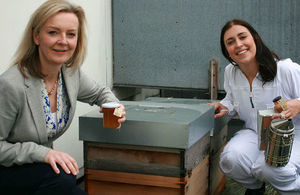Environment Secretary collects first ‘Whitehall Honey’ during National Honey Week
Environment Secretary Elizabeth Truss has collected 60 jars of honey produced by Defra’s bees.

The first jars of honey produced from Defra’s beehives have been collected today by Environment Secretary Elizabeth Truss together with apprentice beekeeper, Lara Manton.
Defra’s first yield of 6.5 kilograms have been bottled with the label ‘Whitehall Honey’ – just in time for National Honey Week
Defra installed beehives on the roof of its building in Westminster to demonstrate the government’s commitment to improving the health and wellbeing of pollinators.
Environment Secretary, Elizabeth Truss said:
Pollinators like bees and butterflies are integral to our natural environment, play a vital role in our food industry and have incredibly deep roots in British culture.
Defra has joined thousands of other urban beekeepers across the country by providing a home for the honeybee – and now we have been rewarded with our very own Whitehall Honey.
We may not all be beekeepers, but we can all do our bit to help these insects flourish, like planting more pollinator-friendly flowers and cutting grass less often.
The government’s National Pollinator Strategy, which was launched last year, aims to raise awareness of what pollinators need to thrive.
As part of the strategy, Defra launched the Bees’ Needs campaign, which consists of 5 simple actions:
-
grow more flowers, shrubs and trees that provide nectar and pollen as food for bees and other pollinators throughout the year.
-
leave patches of land to grow wild with plants like stinging nettles and dandelions to provide other food sources (such as leaves for caterpillars) and breeding places for butterflies and moths.
-
cut grass less often and ideally remove the cuttings to allow plants to flower.
-
avoid disturbing or destroying nesting or hibernating insects, in places like grass margins, bare soil, hedgerows, trees, dead wood or walls.
-
think carefully about whether to use pesticides especially where pollinators are active or nesting or where plants are in flower.